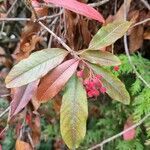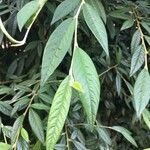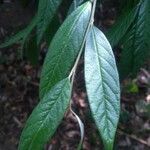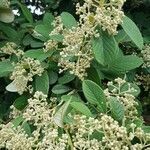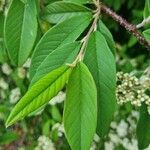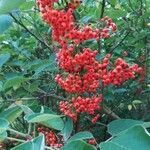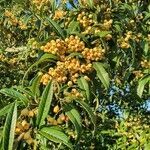Shrubs or trees, 5–15 m. Stems loosely erect, spreading; branches spiraled, dark brown, initially downy. Leaves deciduous; petiole 5–8 mm, densely villose to tomentose; blade narrowly elliptic (to lance-elliptic or narrowly obovate), 55–150 x 19–55 mm, membranous, base cuneate, margins flat, veins 6–10, superficial or slightly sunken, apex acute, abaxial surfaces color not recorded, villous at least near midvein, adaxial green, dull, coating not recorded, flat between lateral veins, glabrous except villous midrib. Inflorescences on fertile shoots 60–80 mm with 2–4 leaves, 20–60-flowered, lax. Pedicels length not recorded, densely tomentose. Flowers 6–7 mm diam.; buds white; hypanthium cupulate [subcylindric], tomentose; sepals: margins tomentose, apex acute, surfaces densely villous; petals spreading, white, glabrous or with hair tuft; stamens 20, filaments white, anthers purple; styles 2. Pomes bright red, subglobose to ellipsoid, 4–6 x 4–5 mm, shiny, not glaucous, sparsely villous; sepals erect or ascending, ?margins tomentose?, densely villous; navel hidden; style remnants near apex. Pyrenes 2. 2n = 34 (India).
A shrub or small tree. It loses its leaves during the year. It grows to 10 m tall. The branches are spreading and young branches are angular. The leaves are narrowly oval and 4-8 cm long by 2-3 cm wide. The fruit is bright red and narrowly oval. It is 4-5 mm across.
